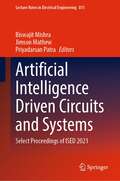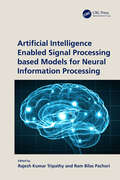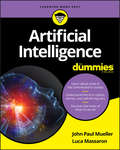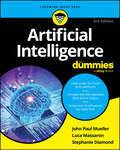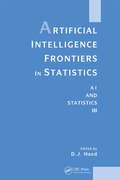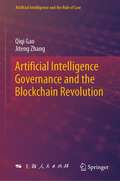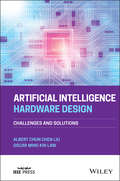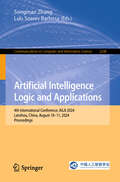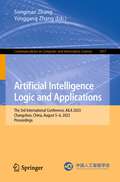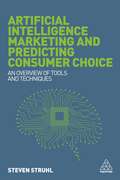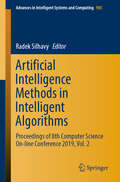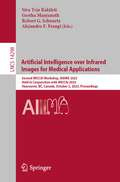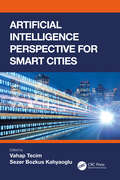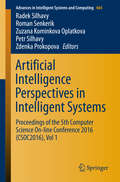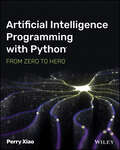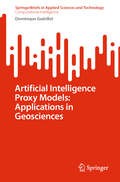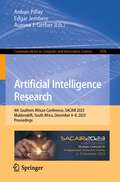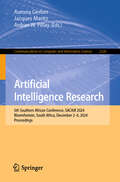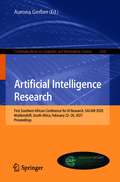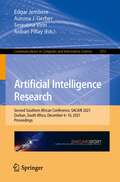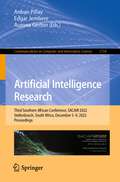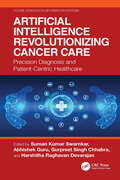- Table View
- List View
Artificial Intelligence Driven Circuits and Systems: Select Proceedings of ISED 2021 (Lecture Notes in Electrical Engineering #811)
by Jimson Mathew Biswajit Mishra Priyadarsan PatraThis book highlights selected papers presented at the 10th International Symposium on Embedded Computing and System Design (ISED) 2021. This symposium provides a platform for researchers to share the latest scientific achievements of embedded computing and system design. The book is divided into three broad sections. The first section discusses topics like VLSI and testing, circuits and systems with a focus on emerging technologies. The second section discusses topics like embedded hardware and software systems and novel applications. The final section discusses the state-of-the-art technologies involving IoT, artificial intelligence, green and edge computing that demonstrates the issues currently.
Artificial Intelligence Enabled Computational Methods for Smart Grid Forecast and Dispatch (Engineering Applications of Computational Methods #14)
by Yong Zhao Zhigang Zeng Lei Wu Yuanzheng LiWith the increasing penetration of renewable energy and distributed energy resources, smart grid is facing great challenges, which could be divided into two categories. On the one hand, the endogenous uncertainties of renewable energy and electricity load lead to great difficulties in smart grid forecast. On the other hand, massive electric devices as well as their complex constraint relationships bring about significant difficulties in smart grid dispatch. Owe to the rapid development of artificial intelligence in recent years, several artificial intelligence enabled computational methods have been successfully applied in the smart grid and achieved good performances. Therefore, this book is concerned with the research on the key issues of artificial intelligence enabled computational methods for smart grid forecast and dispatch, which consist of three main parts. (1) Introduction for smart grid forecast and dispatch, in inclusion of reviewing previous contribution of various research methods as well as their drawbacks to analyze characteristics of smart grid forecast and dispatch.(2) Artificial intelligence enabled computational methods for smart grid forecast problems, which are devoted to present the recent approaches of deep learning and machine learning as well as their successful applications in smart grid forecast.(3) Artificial intelligence enabled computational methods for smart grid dispatch problems, consisting of edge-cutting intelligent decision-making approaches, which help determine the optimal solution of smart grid dispatch. The book is useful for university researchers, engineers, and graduate students in electrical engineering and computer science who wish to learn the core principles, methods, algorithms, and applications of artificial intelligence enabled computational methods.
Artificial Intelligence Enabled Signal Processing based Models for Neural Information Processing
by Ram Bilas Pachori Rajesh Kumar TripathyThe book provides details regarding the application of various signal processing and artificial intelligence-based methods for electroencephalography data analysis. It will help readers in understanding the use of electroencephalography signals for different neural information processing and cognitive neuroscience applications. The book: Covers topics related to the application of signal processing and machine learning-based techniques for the analysis and classification of electroencephalography signals Presents automated methods for detection of neurological disorders and other applications such as cognitive task recognition, and brain-computer interface Highlights the latest machine learning and deep learning methods for neural signal processing Discusses mathematical details for the signal processing and machine learning algorithms applied for electroencephalography data analysis Showcases the detection of dementia from electroencephalography signals using signal processing and machine learning-based techniques It is primarily written for senior undergraduates, graduate students, and researchers in the fields of electrical engineering, electronics and communications engineering, and biomedical engineering.
Artificial Intelligence For Dummies
by John Paul Mueller Luca MassaronStep into the future with AI The term "Artificial Intelligence" has been around since the 1950s, but a lot has changed since then. Today, AI is referenced in the news, books, movies, and TV shows, and the exact definition is often misinterpreted. Artificial Intelligence For Dummies provides a clear introduction to AI and how it’s being used today. Inside, you’ll get a clear overview of the technology, the common misconceptions surrounding it, and a fascinating look at its applications in everything from self-driving cars and drones to its contributions in the medical field. Learn about what AI has contributed to society Explore uses for AI in computer applications Discover the limits of what AI can do Find out about the history of AI The world of AI is fascinating—and this hands-on guide makes it more accessible than ever!
Artificial Intelligence For Dummies
by John Paul Mueller Luca MassaronForget far-away dreams of the future. Artificial intelligence is here now! Every time you use a smart device or some sort of slick technology—be it a smartwatch, smart speaker, security alarm, or even customer service chat box—you’re engaging with artificial intelligence (AI). If you’re curious about how AI is developed—or question whether AI is real—Artificial Intelligence For Dummies holds the answers you’re looking for. Starting with a basic definition of AI and explanations of data use, algorithms, special hardware, and more, this reference simplifies this complex topic for anyone who wants to understand what operates the devices we can’t live without. This book will help you: Separate the reality of artificial intelligence from the hype Know what artificial intelligence can accomplish and what its limits are Understand how AI speeds up data gathering and analysis to help you make informed decisions more quickly See how AI is being used in hardware applications like drones, robots, and vehicles Know where AI could be used in space, medicine, and communication fields sooner than you think Almost 80 percent of the devices you interact with every day depend on some sort of AI. And although you don’t need to understand AI to operate your smart speaker or interact with a bot, you’ll feel a little smarter—dare we say more intelligent—when you know what’s going on behind the scenes. So don’t wait. Pick up this popular guide to unlock the secrets of AI today!
Artificial Intelligence For Dummies
by John Paul Mueller Stephanie Diamond Luca MassaronDive into the intelligence that powers artificial intelligence Artificial intelligence is swiftly moving from a sci-fi future to a modern reality. This edition of Artificial Intelligence For Dummies keeps pace with the lighting-fast expansion of AI tools that are overhauling every corner of reality. This book demystifies how artificial intelligence systems operate, giving you a look at the inner workings of AI and explaining the important role of data in creating intelligence. You'll get a primer on using AI in everyday life, and you'll also get a glimpse into possible AI-driven futures. What's next for humanity in the age of AI? How will your job and your life change as AI continue to evolve? How can you take advantage of AI today to make your live easier? This jargon-free Dummies guide answers all your most pressing questions about the world of artificial intelligence. Learn the basics of AI hardware and software, and how intelligence is created from code Get up to date with the latest AI trends and disruptions across industries Wrap your mind around what the AI revolution means for humanity, and for you Discover tips on using generative AI ethically and effectively Artificial Intelligence For Dummies is the ideal starting point for anyone seeking a deeper technological understanding of how artificial intelligence works and what promise it holds for the future.
Artificial Intelligence Frontiers in Statistics: Al and Statistics III
by David J. HandThis book presents a summary of recent work on the interface between artificial intelligence and statistics. It does this through a series of papers by different authors working in different areas of this interface. These papers are a selected and referenced subset of papers presented at the 3rd Interntional Workshop on Artificial Intelligence and Statistics, Florida, January 1991.
Artificial Intelligence Governance and the Blockchain Revolution (Artificial Intelligence and the Rule of Law)
by Qiqi Gao Jiteng ZhangThis is the first professional academic work in China to discuss artificial intelligence and blockchain together. Artificial intelligence is a productivity revolution, and its development has a significant and profound impact on global changes. However, at the same time, its development also brings a series of challenges to human society, such as privacy, security, and fairness issues. Therefore, the significance of blockchain is even more prominent. Blockchain is a revolution in production relations, which will propose important solutions to the challenges of privacy, security, and fairness that arise after the development of artificial intelligence. The book not only discusses the problems currently faced by the development of artificial intelligence, as well as the new opportunities and challenges that artificial intelligence brings to future global governance, but also explains the further development direction of the intelligent revolution from the perspective of blockchain.
Artificial Intelligence Hardware Design: Challenges and Solutions
by Albert Chun-Chen Liu Oscar Ming LawARTIFICIAL INTELLIGENCE HARDWARE DESIGN Learn foundational and advanced topics in Neural Processing Unit design with real-world examples from leading voices in the field In Artificial Intelligence Hardware Design: Challenges and Solutions, distinguished researchers and authors Drs. Albert Chun Chen Liu and Oscar Ming Kin Law deliver a rigorous and practical treatment of the design applications of specific circuits and systems for accelerating neural network processing. Beginning with a discussion and explanation of neural networks and their developmental history, the book goes on to describe parallel architectures, streaming graphs for massive parallel computation, and convolution optimization. The authors offer readers an illustration of in-memory computation through Georgia Tech’s Neurocube and Stanford’s Tetris accelerator using the Hybrid Memory Cube, as well as near-memory architecture through the embedded eDRAM of the Institute of Computing Technology, the Chinese Academy of Science, and other institutions. Readers will also find a discussion of 3D neural processing techniques to support multiple layer neural networks, as well as information like: A thorough introduction to neural networks and neural network development history, as well as Convolutional Neural Network (CNN) models Explorations of various parallel architectures, including the Intel CPU, Nvidia GPU, Google TPU, and Microsoft NPU, emphasizing hardware and software integration for performance improvement Discussions of streaming graph for massive parallel computation with the Blaize GSP and Graphcore IPU An examination of how to optimize convolution with UCLA Deep Convolutional Neural Network accelerator filter decomposition Perfect for hardware and software engineers and firmware developers, Artificial Intelligence Hardware Design is an indispensable resource for anyone working with Neural Processing Units in either a hardware or software capacity.
Artificial Intelligence Logic and Applications: 4th International Conference, AILA 2024, Lanzhou, China, August 10–11, 2024, Proceedings (Communications in Computer and Information Science #2248)
by Songmao Zhang Luis Soares BarbosaThis book constitutes the proceedings of the 4th International Conference on Artificial Intelligence Logic and Applications, AILA 2024, held in Lanzhou, China, during August 10–11, 2024. The 16 full papers and the 11 short papers included in this volume were carefully reviewed and selected from 45 submissions. The papers cover the following topics: AI logic foundation; AI logic reasoning; AI logic applications.
Artificial Intelligence Logic and Applications: The 2nd International Conference, AILA 2022, Shanghai, China, August 26–28, 2022, Proceedings (Communications in Computer and Information Science #1657)
by Songmao Zhang Yixiang ChenThis book constitutes refereed proceedings of the 2nd International Conference on Artificial Intelligence Logic and Applications 2022 held in Shanghai, China from August 26–28, 2022.The 20 full papers presented in this volume were carefully reviewed and selected from a total of 27 submissions. The papers in the volume are organised according to the following topical headings: program logic; fuzzy logic; applications; author index.
Artificial Intelligence Logic and Applications: The 3rd International Conference, AILA 2023, Changchun, China, August 5–6, 2023, Proceedings (Communications in Computer and Information Science #1917)
by Songmao Zhang Yonggang ZhangThis book constitutes the proceedings of the Third International Conference, AILA 2023, held in Changchun, China, during August 5–6, 2023. The 26 full papers and the 10 short papers included in this volume were carefully reviewed and selected from 56 submissions. This volume aims to provide novel ideas, original research achievements, and practical experiences in a broad range of artificial intelligence logic and applications.
Artificial Intelligence Marketing and Predicting Consumer Choice: An Overview of Tools and Techniques
by Dr Steven StruhlThe ability to predict consumer choice is a fundamental aspect to success for any business. In the context of artificial intelligence marketing, there are a wide array of predictive analytic techniques available to achieve this purpose, each with its own unique advantages and disadvantages. Artificial Intelligence Marketing and Predicting Consumer Choice serves to integrate these widely disparate approaches, and show the strengths, weaknesses, and best applications of each. It provides a bridge between the person who must apply or learn these problem-solving methods and the community of experts who do the actual analysis. It is also a practical and accessible guide to the many remarkable advances that have been recently made in this fascinating field.
Artificial Intelligence Methods in Intelligent Algorithms: Proceedings of 8th Computer Science On-line Conference 2019, Vol. 2 (Advances in Intelligent Systems and Computing #985)
by Radek SilhavyThis book discusses the current trends in and applications of artificial intelligence research in intelligent systems. Including the proceedings of the Artificial Intelligence Methods in Intelligent Algorithms Section of the 8th Computer Science On-line Conference 2019 (CSOC 2019), held in April 2019, it features papers on neural networks algorithms, optimisation algorithms and real-world issues related to the application of artificial methods.
Artificial Intelligence Over Infrared Images for Medical Applications: Second International Workshop, AIIIMA 2023, Held in Conjunction with MICCAI 2023, Vancouver, BC, Canada, October 2, 2023, Proceedings (Lecture Notes in Computer Science #14298)
by Alejandro F. Frangi Robert G. Schwartz Geetha Manjunath Siva Teja KakiletiThis book constitutes the refereed proceedings of the Second Workshop on Artificial Intelligence over Infrared Images for Medical Applications, AIIIMA 2023 held in conjunction with MICCAI 2023, held in Vancouver, BC, Canada, on October 2, 2023. The 10 full papers presented in this book were carefully peer reviewed and selected from 15 submissions. The second workshop on AIIIMA, similarily to the first, aimes to create a forum to discuss the specific sub-topic of AI over Infrared Images for Medical Applications at MICCAI and promote this novel area of research, that has the potential to hugely impact our society, among the research community.
Artificial Intelligence Perspective for Smart Cities
by Vahap Tecim Sezer Bozkus KahyaogluThe concept of a "smart city" is used widely in general; however, it is hard to explain because of the complexity and multidimensionality of this notion. However, the essential qualification for being a smart city is to achieve "sustainable social, environmental, and economic development" and boost the living standards of society based on Information and Communication Technology (ICT) and Artificial intelligence (AI). AI in smart cities has become an important aspect for cities that face great challenges to make smart decisions for social well-being, particularly cybersecurity and corporate sustainability. In this context, we aim to contribute literature with a value-added approach where various AI applications of smart cities are discussed from a different perspective. First, we start by discussing the conceptual design, modeling, and determination of components for the sustainability of a smart city structure. Since smart cities operate on spatial-based data, it is important to design, operate, and manage smart city elements using Geographical Information Systems (GIS) technologies. Second, we define the structure, type, unit, and functionality of the layers to be placed on the GIS to achieve best practices based on Industry 4.0 components. Transportation is one of the key indicators of smart cities, so it is critical to make transportation in smart cities accessible for different disabled groups by using AI technologies. Third, we demonstrate what kinds of technologies should be used for which disabled groups in different transportation vehicles with specific examples. Finally, we create a discussion platform for processes and sub-processes such as waste management, emergency management, risk management, and data management for establishing smart cities including the financial and ethical aspects.
Artificial Intelligence Perspectives in Intelligent Systems: Proceedings of the 5th Computer Science On-line Conference 2016 (CSOC2016), Vol 1 (Advances in Intelligent Systems and Computing #464)
by Radek Silhavy Roman Senkerik Zuzana Kominkova Oplatkova Petr Silhavy Zdenka ProkopovaThis volume is based on the research papers presented in the 5th Computer Science On-line Conference. The volume Artificial Intelligence Perspectives in Intelligent Systems presents modern trends and methodsto real-world problems, and in particular, exploratory research that describes novel approaches in the field of artificial intelligence. New algorithms in a variety of fields are also presented. The Computer Science On-line Conference (CSOC 2016) is intended to provide an international forum for discussions on the latest research results in all areas related to ComputerScience. The addressed topics are the theoretical aspects and applications of Computer Science, Artificial Intelligences, Cybernetics, Automation Control Theory and Software Engineering.
Artificial Intelligence Programming with Python: From Zero to Hero
by Perry XiaoA hands-on roadmap to using Python for artificial intelligence programming In Practical Artificial Intelligence Programming with Python: From Zero to Hero, veteran educator and photophysicist Dr. Perry Xiao delivers a thorough introduction to one of the most exciting areas of computer science in modern history. The book demystifies artificial intelligence and teaches readers its fundamentals from scratch in simple and plain language and with illustrative code examples. Divided into three parts, the author explains artificial intelligence generally, machine learning, and deep learning. It tackles a wide variety of useful topics, from classification and regression in machine learning to generative adversarial networks. He also includes: Fulsome introductions to MATLAB, Python, AI, machine learning, and deep learning Expansive discussions on supervised and unsupervised machine learning, as well as semi-supervised learning Practical AI and Python “cheat sheet” quick referencesThis hands-on AI programming guide is perfect for anyone with a basic knowledge of programming—including familiarity with variables, arrays, loops, if-else statements, and file input and output—who seeks to understand foundational concepts in AI and AI development.
Artificial Intelligence Proxy Models: Applications in Geosciences (SpringerBriefs in Applied Sciences and Technology)
by Dominique GuérillotThis Springer Brief focuses on the use of artificial intelligence (AI) in geosciences and reservoir engineering. This concise yet comprehensive work explores how AI-driven proxy models can effectively tackle the computational challenges associated with reservoir simulations, history matching, production optimization, and uncertainty analysis. In reservoir engineering, a key challenge is reproducing observed production and pressure data using forward simulation models, known as reservoir simulators. However, the inverse problem of history matching requires running hundreds of simulations, each demanding significant computational resources. Full-scale reservoir simulators are often too time-consuming, making proxy models—such as second-order polynomials, kriging, and artificial neural networks (ANN)—essential alternatives. This Springer Brief emphasizes the power of AI, particularly ANN, as the most pragmatic approach for addressing real-world reservoir engineering problems. ANN has already gained widespread acceptance in computationally intensive fields such as aerospace, defense, and security due to its ability to model nonlinearities. Given the highly nonlinear nature of reservoir simulations, this book demonstrates how artificial neural networks-based proxies provide efficient and accurate solutions. To illustrate these concepts, the methodology is applied to a synthetic field inspired by real-world data: the Brugge field dataset. This widely used open-source dataset enables practitioners to familiarize themselves with AI-driven workflows in reservoir simulation. The Brief covers key applications, including history matching, production optimization (e.g., well placement and production rates), and uncertainty analysis, with detailed explanations of the workflows for each case. This Brief offers high-quality scientific content aligned with international research standards. It is now available in both print and digital formats.
Artificial Intelligence Research: 4th Southern African Conference, SACAIR 2023, Muldersdrift, South Africa, December 4–8, 2023, Proceedings (Communications in Computer and Information Science #1976)
by Edgar Jembere Aurona J. Gerber Anban PillayThis book constitutes the refereed proceedings of the 4th Southern African Conference on Artificial Intelligence Research, SACAIR 2023, held in Muildersdrift, South Africa, in December 2023. The 22 full papers presented in these proceedings were carefully reviewed and selected from 66 submissions. The papers are organized in the following topical sections: Responsible and Ethical AI Track; Socio-Technical and Human-Centered AI Track; Algorithmic, and Data Driven and Symbolic AI.
Artificial Intelligence Research: 5th Southern African Conference, SACAIR 2024, Bloemfontein, South Africa, December 2–6, 2024, Proceedings (Communications in Computer and Information Science #2326)
by Aurona Gerber Jacques Maritz Anban W. PillayThis book constitutes the refereed proceedings of the 5th Southern African Conference on Artificial Intelligence Research, SACAIR 2024, held in Bloemfontein, South Africa, during December 2–6, 2024. The 29 full papers presented in these proceedings were carefully reviewed and selected from 101 submissions. The papers are organized in the following topical sections: algorithmic and Data Driven AI; socio-technical and human-centred AI (Information Systems); responsible and Ethical AI (Philosophy, Law and Humanities); symbolic AI and Knowledge Representation and Reasoning.
Artificial Intelligence Research: First Southern African Conference for AI Research, SACAIR 2020, Muldersdrift, South Africa, February 22-26, 2021, Proceedings (Communications in Computer and Information Science #1342)
by Aurona GerberThis book constitutes the refereed proceedings of the First Southern African Conference on Artificial Intelligence Research, SACAIR 2020, held in Muldersdrift, South Africa, in February 2021. Due to the COVID-19 pandemic the SACAIR 2020 has been postponed to February 2021. The 19 papers presented were thoroughly reviewed and selected from 53 submissions. They are organized on the topical sections on AI for ethics and society; AI in information systems, AI for development and social good; applications of AI; knowledge representation and reasoning; machine learning theory.
Artificial Intelligence Research: Second Southern African Conference, SACAIR 2021, Durban, South Africa, December 6–10, 2021, Proceedings (Communications in Computer and Information Science #1551)
by Serestina Viriri Edgar Jembere Aurona J. Gerber Anban PillayThis book constitutes the refereed proceedings of the Second Southern African Conference on Artificial Intelligence Research, SACAIR 2021, held in Durban, South Africa, in December 2021. Due to the COVID-19 pandemic the SACAIR 2021 was held online. The 22 papers presented were thoroughly reviewed and selected from the 70 submissions. They are organized on the topical sections on AI in the humanities and society, AI in and for information systems, computer vision and image processing, deep learning, knowledge representation and reasoning, machine learning, philosophy and ethics of AI.
Artificial Intelligence Research: Third Southern African Conference, SACAIR 2022, Stellenbosch, South Africa, December 5–9, 2022, Proceedings (Communications in Computer and Information Science #1734)
by Aurona Gerber Edgar Jembere Anban PillayThis book constitutes the refereed proceedings of the Third Southern African Conference on Artificial Intelligence Research, SACAIR 2022, held in Stellenbosch, South Africa, in December 2022. The 26 papers presented were thoroughly reviewed and selected from the 73 submissions. They are organized on the topical sections on algorithmic, data driven and symbolic AI; socio-technical and human-centered AI; responsible and ethical AI.
Artificial Intelligence Revolutionizing Cancer Care: Precision Diagnosis and Patient-Centric Healthcare (Future Generation Information Systems)
by Suman Kumar Swarnkar Gurpreet Singh Chhabra Abhishek Guru Harshitha Raghavan DevarajanIn the ever-evolving landscape of cancer treatment, the fusion of artificial intelligence (AI) with medical science marks a groundbreaking shift toward more precise, efficient, and personalized healthcare. Artificial Intelligence Revolutionizing Cancer Care: Precision Diagnosis and Patient-Centric Healthcare delves into the transformative power of AI, offering a comprehensive exploration of its role in enhancing cancer diagnosis, treatment, and patient management. This edited volume brings together leading experts and researchers who illuminate the latest advancements in AI technologies applied to oncology. From machine learning algorithms that predict cancer progression to sophisticated imaging techniques that improve diagnostic accuracy, this book covers a spectrum of innovations reshaping cancer care. Key highlights include precision diagnosis, uncovering how AI-driven tools are revolutionizing the early detection and accurate classification of various cancer types, leading to better patient outcomes; patient-centric approaches, exploring the shift toward personalized medicine, where AI tailors treatment protocols to individual patient profiles, ensuring more effective and targeted therapies; and ethical and practical considerations, gaining insights into the ethical, practical, and regulatory challenges of integrating AI in healthcare, emphasizing the need for patient privacy and data security. Additionally, the book looks ahead to the potential future applications of AI in oncology, including predictive analytics, robotic surgery, and beyond. Artificial Intelligence Revolutionizing Cancer Care is an essential resource for medical professionals, researchers, and students seeking to understand the intersection of AI and oncology. It offers a visionary perspective on how cutting-edge technology is poised to enhance patient care and transform the fight against cancer.This book focuses on the critical intersection of artificial intelligence and cancer diagnosis within the healthcare sector emphasizes the real-world impact of artificial intelligence in improving cancer detection, treatment, and overall patient care covers artificial intelligence algorithms, machine learning techniques, medical image analysis, predictive modeling, and patient care applications explores how artificial intelligence technologies enhance the patient’s experience, resulting in better outcomes and reduced healthcare disparities provides readers with an understanding of the mathematics underpinning machine learning models, including decision trees, support vector machines, and deep neural networks It is primarily written for senior undergraduates, graduate students, and academic researchers in the fields of electrical engineering, electronics and communications engineering, computer science and engineering, biomedical engineering, and information technology.
